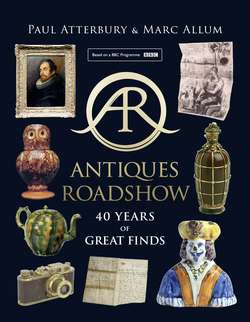Читать книгу Antiques Roadshow: 40 Years of Great Finds - Paul Atterbury, Paul Atterbury - Страница 11
A RICHARD DADD PAINTING
Оглавление‘If it is night when you arrive, the effects of light and shadow are something only to be painted, not described… At times the excitement of these scenes has been enough to turn the brain of an ordinary weak-minded person like myself… The moon rose again after some time, and we, having stayed two hours, mounted and rode through the mountains of Engaddi.’
Richard Dadd, letter to William Powell Frith, 26 November 1842
With all the pressure and excitement of a Roadshow day, there is little time for detailed research. Sometimes objects – most frequently paintings – have been filmed but left unresolved on the day, pending further investigation. Based on their knowledge and instinct, specialists have made firm pronouncements but require more time to establish these as certainties. In some cases, where subsequent research has proved the specialist right, items have been followed up on a later Roadshow.
The first Roadshow in the 1986 season was filmed in May at Barnstaple’s North Devon Leisure Centre. While walking past a long queue on the way to his table, Peter Nahum noticed a large painting held between two pieces of cardboard. Two hours later, this painting finally reached him and he was able to look properly at what turned out to be one of the Roadshow’s greatest finds. A specialist in nineteenth-century painting, Peter was one of the few people who would have known that he was looking at a long-lost work by Richard Dadd, which just goes to show that Roadshow finds can depend as much on luck as on knowledge.
THE TRAVELLING PAINTER
Richard Dadd was born in Kent in 1817, the fourth of seven children. He began drawing at the age of thirteen, and at twenty he enrolled as a student at the Royal Academy Schools in London. Initially, he concentrated on subjects taken from history and literature, but his fame really grew in the early 1840s, when he began to exhibit paintings with fairy subjects – a popular theme in mid-Victorian Britain. In 1842, Dadd set off with his patron, Sir Thomas Phillips, on an extensive tour of Europe and the Middle East, including Belgium, Germany, Italy, Greece, Cyprus, Turkey, Syria, Palestine and Egypt. In November 1842, the party spent two weeks in the Holy Land, visiting Jerusalem, Jordan and the Dead Sea, a tour that included a crossing of the Engaddi mountains by night. It was during this trip that Dadd began to exhibit signs of the madness that was to affect him for the rest of his life. He believed that it was his duty to kill those, such as the Pope, who held religious views that differed from his own. Having fallen out with Phillips, he returned to Britain. Such was his mental deterioration that he believed himself under the influence of the Egyptian god Osiris and, in August 1843, he murdered his own father. He fled to France, was captured, brought back to Britain and committed to Bethlem Hospital in London. He remained there until 1864 when he was transferred to Broadmoor, where he died in 1886. At Bethlem, Dadd was encouraged to paint, and sometimes he used his notebooks and sketchbooks to produce works documenting his tour with Phillips.
Peter Nahum, who had seen many examples of Dadd’s work during his career as an auctioneer and art dealer, believed that the large watercolour shown to him in Barnstaple was one of a series painted by Dadd at Bethlem in about 1845. Having had it for years, the owners had hung it in their living room but, believing it to be a print, were about to put it away in the garden shed when they brought it to the Roadshow. Though certain of his attribution, which was also based on the French inscription on the back of the painting, Peter knew he could not prove it without further research, and so he filmed it without a valuation.
Encouraged by the BBC, Peter set to work. Archives at the Bethlem Royal Hospital Museum revealed that the painting could be one of three watercolours known to have been painted there but subsequently lost, while further evidence was supplied by a sketchbook in the Victoria & Albert Museum. In 1857, three Dadd watercolours owned by the Preston collector Thomas Birchall were loaned to the Manchester Art Treasures Exhibition. One of these was entitled Halt in the Desert. Also known as Encampment or Moonlight in the Desert, this appeared to be the painting discovered in Barnstaple. In 1862, the same painting was shown at the International Exhibition in London, where a critic described it as having ‘a wild feeling, one hardly knows whether more poetical or insane…’ At that point this painting, and the other two – catalogued as Dead Camel and Moonlight in the Desert – disappeared, perhaps lost when Thomas Birchall’s collection was dispersed.
A PROVENANCE CONFIRMED
With the attribution confirmed, the painting, now with its full title, The Artist’s Halt in the Desert, appeared again on a Roadshow in 1987, and Peter was able to provide many details about the painting and its history. He established that among the group around the camp fire are Sir Thomas Phillips and Dadd himself, seated on the far right. The same year, the painting was acquired by the British Museum via a private treaty sale arranged with the owners, for a price of £100,000. This included a contribution from the National Heritage Memorial Fund. At the time, it was the most expensive item to have been found on the Antiques Roadshow.
Since then the painting, now acknowledged as a major work by Dadd, has been widely exhibited in the UK and abroad, and has also been included in exhibitions in Mexico, the United States and Abu Dhabi.
